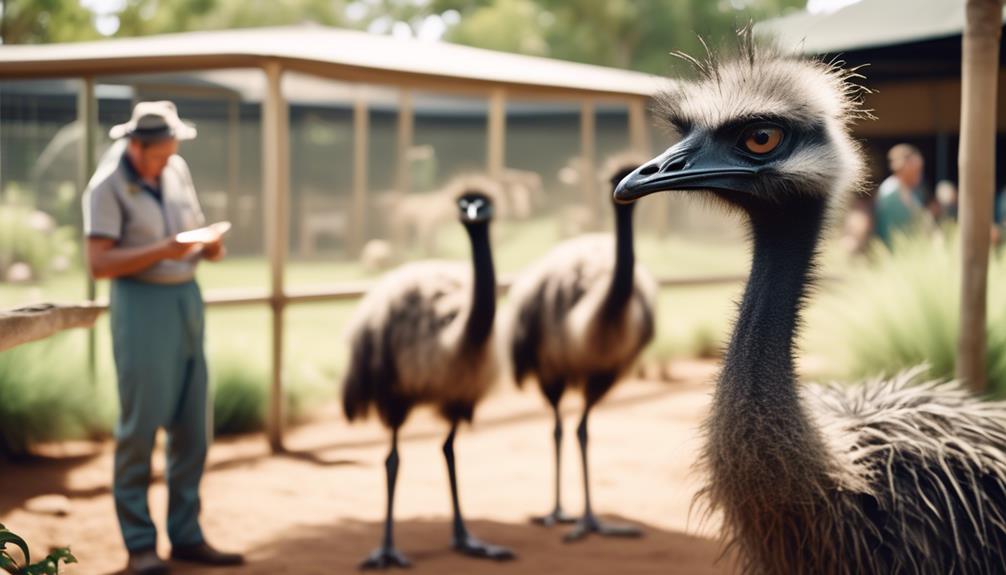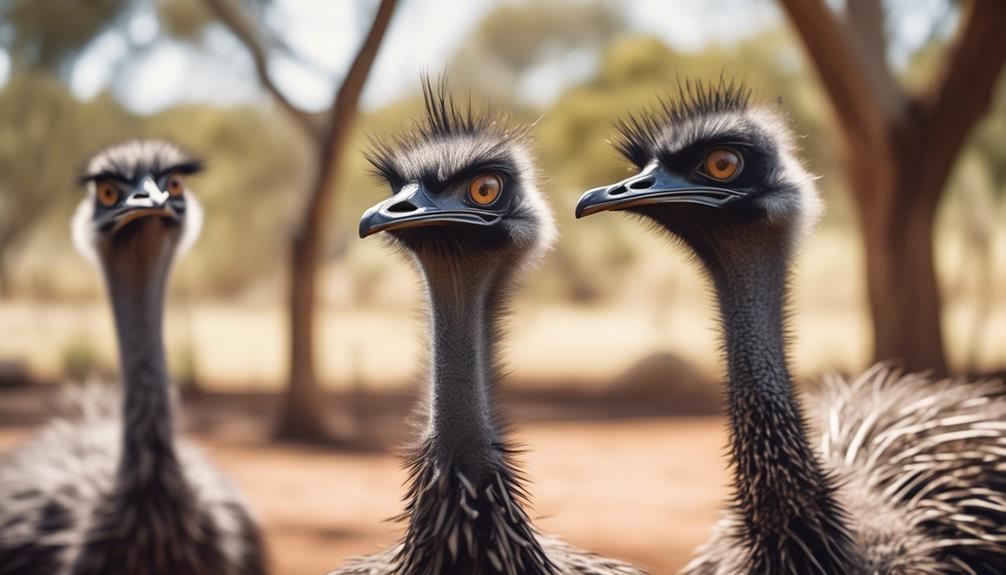
Are you prepared to embark on an avian adventure like no other? Welcome to the ultimate guide to Emu bird care: a comprehensive collection of tips and tricks to ensure the well-being and happiness of these remarkable creatures.
From their unique diet and nutrition requirements to creating the perfect housing and enclosure, this guide will equip you with the knowledge and tools needed to provide the optimal care for these fascinating birds.
But that's not all – we will also explore their health and veterinary care, socialization and behavior, egg incubation and hatching, feather care and grooming, breeding and reproduction, and even training and enrichment.
So, fasten your seatbelt and get ready to discover the secrets of Emu bird care.
Key Takeaways
- Emus require a diet that is low in fat and high in protein, with a balanced ratio of vitamins and minerals. Calcium is also important and can be provided through supplements or crushed oyster shells or cuttlefish bones.
- Emus need ample space to roam and exercise, with a minimum enclosure size of one acre per pair of emus. The enclosure should be securely fenced with a minimum height of six feet and have shelters or sheds for protection from extreme weather conditions.
- Regular veterinary care and disease prevention are essential for maintaining the health and well-being of emus. Clean and hygienic environments, as well as knowledge of first aid and emergency care, are important.
- Emus are highly social birds and thrive in groups. They should ideally be kept in groups of at least three or four individuals. Providing a spacious and stimulating enclosure with areas for gathering is crucial for emu socialization.
Emu Diet and Nutrition
To ensure optimal health and well-being for your emu bird, it's crucial to understand the importance of a balanced diet and proper nutrition.
Emu feeding habits are unique and require specific attention to meet their nutritional requirements. Emus are omnivorous birds that consume a variety of foods in the wild, including plants, insects, fruits, and small animals.
In captivity, emus should be fed a diet that mimics their natural feeding habits. This means providing them with a mix of high-quality emu pellets, fresh fruits and vegetables, and a source of animal protein such as mealworms or crickets. It's important to ensure that the emu's diet is well-balanced and includes all the necessary nutrients they need to thrive.
Emus have specific nutritional requirements that must be met for their overall health and well-being. They require a diet that's low in fat and high in protein, with a balanced ratio of vitamins and minerals. Emus also need a source of calcium, either through supplements or by providing them with access to crushed oyster shells or cuttlefish bones.
Emu Housing and Enclosure
Emu housing and enclosure play a crucial role in providing the necessary space, security, and environmental conditions for optimal emu health and well-being. When designing an emu enclosure, it is important to consider the natural behaviors and needs of these magnificent birds. Emus are large, flightless birds that require ample space to roam and exercise. A well-designed enclosure should have a minimum size of one acre per pair of emus. It should be securely fenced with a minimum height of six feet to prevent escape and protect them from predators.
In terms of housing materials, sturdy and durable materials are essential. Emus have strong beaks and can easily damage weak fencing or structures. Chain-link fencing or welded wire mesh are good options for the perimeter. Additionally, the enclosure should have shelters or sheds to provide protection from extreme weather conditions such as heat, cold, and rain.
To provide a more intimate understanding of the importance of emu housing and enclosure, let's take a look at the table below:
| Emu Enclosure Design | Emu Housing Materials |
|---|---|
| Spacious and secure | Sturdy chain-link fencing or welded wire mesh |
| Adequate shelters or sheds for weather protection | Durable materials resistant to beak damage |
Emu Health and Veterinary Care

Emus require regular veterinary care and attention to maintain their health and well-being. Disease prevention is crucial in ensuring the longevity and vitality of these magnificent birds. Regular check-ups with a qualified avian veterinarian are essential to monitor their overall health and address any potential issues early on.
To prevent diseases, it's important to maintain a clean and hygienic environment for your emus. Regularly clean their enclosures, remove any droppings, and provide fresh water and nutritious food. Ensure that their living space is well-ventilated and protected from extreme weather conditions.
In addition to disease prevention, it's crucial to be prepared for emergencies. First aid and emergency care knowledge can make a significant difference in saving your emu's life in critical situations. Familiarize yourself with basic first aid techniques such as wound cleaning, bandaging, and immobilization.
However, it's important to remember that veterinary care should always be sought in emergencies or if you're unsure of how to handle a particular situation. A quick response and immediate professional assistance can greatly increase the chances of a successful outcome.
Emu Socialization and Behavior
Understanding the socialization and behavior of emus is essential for their proper care and well-being. Emus are highly social birds, and they thrive in groups. They form strong bonds with their flock members and establish a hierarchy within the group. To ensure that your emu feels comfortable and happy, it is important to provide them with opportunities for social interaction and enrichment.
Here are some emu socialization tips to keep in mind:
- Flock size: Emus are gregarious birds and should ideally be kept in groups of at least three or four individuals. This allows them to engage in natural social behaviors and reduces the likelihood of stress or loneliness.
- Enclosure design: Creating a spacious and stimulating enclosure is crucial for emu socialization. Provide areas for the emus to gather, such as perches or platforms, as well as areas for individual retreat.
To understand emu behavior better, let's take a look at the table below:
| Behavior | Description |
|---|---|
| Vocalization | Emus communicate through various vocalizations, including booming calls, grunts, and hisses. |
| Courtship | During breeding season, male emus perform elaborate displays to attract females. This includes drumming their feet, puffing up their feathers, and emitting low-frequency calls. |
| Foraging | Emus are opportunistic feeders and will eat a variety of plant matter, insects, and small vertebrates. They use their sharp beaks to peck at food and can consume large quantities in a short amount of time. |
| Nesting | Female emus construct large nests on the ground using twigs, leaves, and grass. They lay several dark green eggs in the nest, which are then incubated by the male. |
| Aggression | Emus can display aggressive behavior, especially during mating season or when defending territory. This may include charging, kicking, or pecking. |
Emu Egg Incubation and Hatching

To successfully incubate and hatch emu eggs, careful attention must be paid to temperature, humidity, and turning frequency. Emu egg temperature control is crucial throughout the incubation process. Maintain a consistent temperature of 97.5°F (36.4°C) using an incubator. Fluctuations can lead to improper development or even death of the embryos.
Additionally, it's essential to monitor humidity levels. Aim for 25-35% humidity during the first 25 days and increase it to 50-60% during the last few days of incubation. This mimics the natural environment and facilitates hatching.
Proper turning of the eggs is also necessary. Emu eggs should be turned at least three times a day for the first 50 days. This prevents the embryos from sticking to the shell and promotes even development. However, avoid turning the eggs during the last three days before hatching.
Once the emu chicks hatch, it's important to provide them with the right care and environment. Emu chick rearing techniques involve providing a brooder box with a heat source, such as a heat lamp, to maintain a temperature of around 90°F (32.2°C). Ensure clean water and a balanced diet consisting of high-quality emu starter feed and fresh greens. Regularly clean the brooder box to maintain hygiene and prevent diseases.
Emu Feather Care and Grooming
After successfully hatching emu chicks, it is important to ensure their feathers receive proper care and grooming to maintain their health and functionality. Emu feathers play a crucial role in the bird's ability to regulate body temperature, provide protection, and aid in flightless locomotion. To keep their feathers in optimal condition, regular cleaning is necessary. Feather cleaning helps remove dirt, debris, and excess oil that can accumulate on the feathers, preventing them from functioning effectively.
One common issue that emus may encounter is feather mites. These tiny parasites can infest the feathers and cause discomfort and irritation for the bird. Regular inspection of the feathers is essential to identify any signs of infestation. If feather mites are detected, it is crucial to take immediate action to prevent their spread and alleviate the bird's discomfort.
To engage the audience further, here is a table providing a summary of important points to consider when caring for emu feathers:
| Feather Care Tips | Feather Grooming Techniques | Common Signs of Feather Mites |
|---|---|---|
| Regular cleaning | Gently remove debris | Itching and scratching |
| Inspect for mites | Use a soft brush | Feather damage |
| Prevent infestations | Avoid excessive oiling | Feather loss |
Emu Breeding and Reproduction

Emu breeding and reproduction involves a complex process that requires careful consideration of various factors to ensure successful mating and healthy offspring. Emus are known for their unique mating rituals, which involve intricate dances and vocalizations. These rituals are a crucial part of courtship, allowing the male and female emus to establish a strong bond before mating.
During the breeding season, male emus become more territorial and aggressive, marking their territory and defending it from other males. They puff up their feathers, fan their tail, and emit low booming sounds to attract females. Once a female is interested, she'll respond by circling the male, mirroring his movements, and making soft grunting sounds.
After successful courtship, the female emu will begin the process of nest building. She selects a suitable location, usually a shallow depression on the ground, and starts collecting materials such as leaves, grass, and sticks to construct the nest. The female emu is solely responsible for nest building, which can take several weeks to complete.
Once the nest is ready, the female emu will lay a clutch of large, dark green eggs. The male emu then takes on the role of incubation, carefully sitting on the eggs for approximately 8 weeks until they hatch. This division of labor is unique among birds and ensures the survival of the offspring.
Understanding and respecting the intricate process of emu breeding and reproduction is essential for successful breeding and the well-being of these magnificent birds.
Emu Training and Enrichment
Training and enriching emus involves implementing a structured program that focuses on positive reinforcement and providing stimulating activities to enhance their cognitive and physical well-being. Emu behavioral training is essential for ensuring their safety and promoting their overall health. By using positive reinforcement techniques such as rewards and praise, emus can be trained to respond to commands and engage in desired behaviors. Enrichment activities for emus are also crucial in preventing boredom and promoting mental stimulation. These activities simulate natural behaviors and provide opportunities for exercise and exploration. To give you some ideas, here is a table showcasing a few examples of enrichment activities for emus:
| Enrichment Activity | Benefits |
|---|---|
| Scatter Feeding | Stimulates natural foraging behavior |
| Puzzle Feeders | Promotes problem-solving skills |
| Mirror Play | Provides social stimulation and curiosity |
| Environmental Manipulation | Encourages exploration and physical exercise |
Implementing a variety of these activities in their daily routine will help keep emus engaged and mentally stimulated. Remember, emus are intelligent creatures that thrive when provided with opportunities for learning and play. By incorporating behavioral training and enrichment activities into their care, you can ensure that your emu is happy, healthy, and fulfilling its full potential.
Frequently Asked Questions
How Long Do Emus Live on Average?
Emus, on average, live for about 10 to 20 years. Their lifespan can be influenced by various factors, including their breeding patterns. Understanding these patterns can help ensure the long-term health and well-being of your emus.
Are Emus Aggressive Towards Humans?
Emus can be aggressive towards humans, especially if they feel threatened or provoked. It's important to be cautious around them, especially when children are present. They may also display territorial behavior towards other animals.
Can Emus Fly?
Emus, with their large size and strong legs, are flightless birds. Their adaptations, such as reduced wing size and heavy bodies, make it impossible for them to fly. Instead, they are excellent runners and can reach speeds of up to 30 miles per hour.
Are There Any Legal Requirements or Permits Needed to Own an Emu?
To own an emu, you need to be aware of the legal requirements and permits involved. These regulations vary by location, so it's crucial to research and comply with your local laws before bringing home this unique bird.
What Is the Best Way to Prevent Emus From Escaping Their Enclosure?
To prevent emus from escaping their enclosure, make sure your emu enclosure design is secure and includes high fences, reinforced gates, and buried wire mesh. Effective emu deterrents like noise makers can also discourage escape attempts.
Conclusion
Congratulations on completing the ultimate guide to emu bird care!
By following the tips and tricks outlined here, you're well-equipped to provide the best care for your emu.
Did you know that emus can reach speeds of up to 30 miles per hour? It's fascinating how these incredible birds have adapted to their environment.
Remember to maintain a balanced diet, ensure proper housing, prioritize veterinary care, promote socialization, and practice regular grooming.
With this knowledge, you'll be able to create a thriving environment for your emu. Happy bird-keeping!




